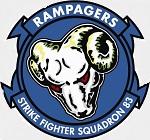Hobby Master HA3555 US Navy Boeing F/A-18C Hornet Strike Fighter - VFA-83 "Rampagers," Naval Air Station Oceana, Virginia, 2005 (1:72 Scale)
"Television brought the brutality of war into the comfort of the living room. Vietnam was lost in the living rooms of America - not on the battlefields of Vietnam."
- Marshal McLuhan
 The F/A-18 Hornet is the true multi-role aircraft. It can vault from a carrier deck, bomb a target and stay to dogfight even the best enemy aircraft without missing a beat. It's the Navy's first modern-era jet intended for double duty against air- and ground-based adversaries. Armed to the hilt with Sparrow and Sidewinder air-to-air missiles, an internal cannon, and laser-guided bombs, this modern warbird was an outstanding performer in Operation Desert Storm. Strapped into a digital cockpit described as a cross between Star Wars and a video game, pilots of the F/A-18 Hornet take on the ultimate aviation job: blasting this single-seat, high-performance jet off the deck of a carrier, dropping bombs, and firing air-to-ground ordnance. Offering unmatched agility, the Hornet is the choice aircraft of the US Navy's elite Blue Angels aerobatic team.
The F/A-18 Hornet is the true multi-role aircraft. It can vault from a carrier deck, bomb a target and stay to dogfight even the best enemy aircraft without missing a beat. It's the Navy's first modern-era jet intended for double duty against air- and ground-based adversaries. Armed to the hilt with Sparrow and Sidewinder air-to-air missiles, an internal cannon, and laser-guided bombs, this modern warbird was an outstanding performer in Operation Desert Storm. Strapped into a digital cockpit described as a cross between Star Wars and a video game, pilots of the F/A-18 Hornet take on the ultimate aviation job: blasting this single-seat, high-performance jet off the deck of a carrier, dropping bombs, and firing air-to-ground ordnance. Offering unmatched agility, the Hornet is the choice aircraft of the US Navy's elite Blue Angels aerobatic team.
The F/A-18C is the single-seat variant and the F/A-18D is the two-seat variant. The D-model can be configured for training or as an all-weather strike craft. The "missionized" D model's rear seat is configured for a Marine Corps Naval Flight Officer who functions as a Weapons and Sensors Officer to assist in operating the weapons systems. The F/A-18D is primarily operated by the U.S. Marine Corps in the night attack and Forward Air Controller (Airborne) (FAC(A)) roles.
The F/A-18C and D models are the result of a block upgrade in 1987 incorporating upgraded radar, avionics, and the capacity to carry new missiles such as the AIM-120 AMRAAM air-to-air missile and AGM-65 Maverick and AGM-84 Harpoon air-to-surface missiles. Other upgrades include the Martin-Baker NACES (Navy Aircrew Common ejection seat), and a self-protection jammer. A synthetic aperture ground mapping radar enables the pilot to locate targets in poor visibility conditions. C and D models delivered since 1989 also have improved night attack abilities, consisting of the Hughes AN/AAR-50 thermal navigation pod, the Loral AN/AAS-38 NITE Hawk FLIR (forward looking infrared array) targeting pod, night vision goggles, and two full-color (formerly monochrome) multi-function display (MFDs) and a color moving map.
Pictured here is a gorgeous 1:72 scale diecast replica of a US Navy Boeing F/A-18C Hornet Strike Fighter that was attached to VFA-83 "Rampagers," then deployed to Naval Air Station Oceana, Virginia, during 2005.
Sold Out!
Dimensions:
Wingspan: 7-1/2-inches
Length: 9-inches
Release Date: June 2021
 Historical Account: "Rampagers" - Strike Fighter Squadron 83 (VFA-83), also known as the "Rampagers", are a United States Navy F/A-18E Super Hornet fighter squadron stationed at Naval Air Station Oceana. They are a part of Carrier Air Wing 3, their tailcode is AC and their radio call sign is Ram.
Historical Account: "Rampagers" - Strike Fighter Squadron 83 (VFA-83), also known as the "Rampagers", are a United States Navy F/A-18E Super Hornet fighter squadron stationed at Naval Air Station Oceana. They are a part of Carrier Air Wing 3, their tailcode is AC and their radio call sign is Ram.
In mid-1990, they made their first Hornet deployment aboard USS Saratoga in support of Operation Desert Shield and Operation Desert Storm. For 43 days they flew 237 combat missions over Iraq and Kuwait, they were awarded the 1990 COMNAVAIRLANT Battle "E" and the 1991 CNO Aviation Safety Award.
In 1992, they deployed to the Adriatic Sea supporting United Nations operations in former Yugoslavia. In 1994, they made a second deployment to the area, which also marked the first ever detachment to Jordan. They were awarded their sixth CNO Aviation Safety Award in 1994. In 1996, the squadron deployed to the Mediterranean Sea, the Adriatic Sea and the Persian Gulf on board USS Enterprise in support of Operation Southern Watch. In 1996, they were awarded the Battle "E" and Michael J. Estocin Award, as the best F/A-18 squadron in the US Navy. The squadron was then equipped with the F/A-18C(N). In April 1998, VFA-83 was relocated to NAS Oceana, Virginia. During the same year the squadron was deployed aboard USS Dwight D. Eisenhower to the Mediterranean Sea.
CVW-17 was then reassigned to the carrier USS George Washington and made two deployments to the Mediterranean Sea and the Arabian Sea in 2000 and 2002, supporting Operation Enduring Freedom and Operation Iraqi Freedom. These operations continued in 2004 during the last deployment of USS John F. Kennedy.
VFA-83 was then reassigned to Carrier Air Wing Seven and deployed again on USS Dwight D. Eisenhower to the Mediterranean Sea and the Indian Ocean from October 2006 to May 2007. As USS Dwight D. Eisenhower was refitted in 2008, the strike fighter squadrons of CVW-7 were assigned to CVW-17 and conducted a work-up period on USS George Washington. During that cruise CVW-7's squadrons retained their tail code "AG".
As of August 2018, the Rampagers have transitioned to the F/A-18 Super Hornet.


